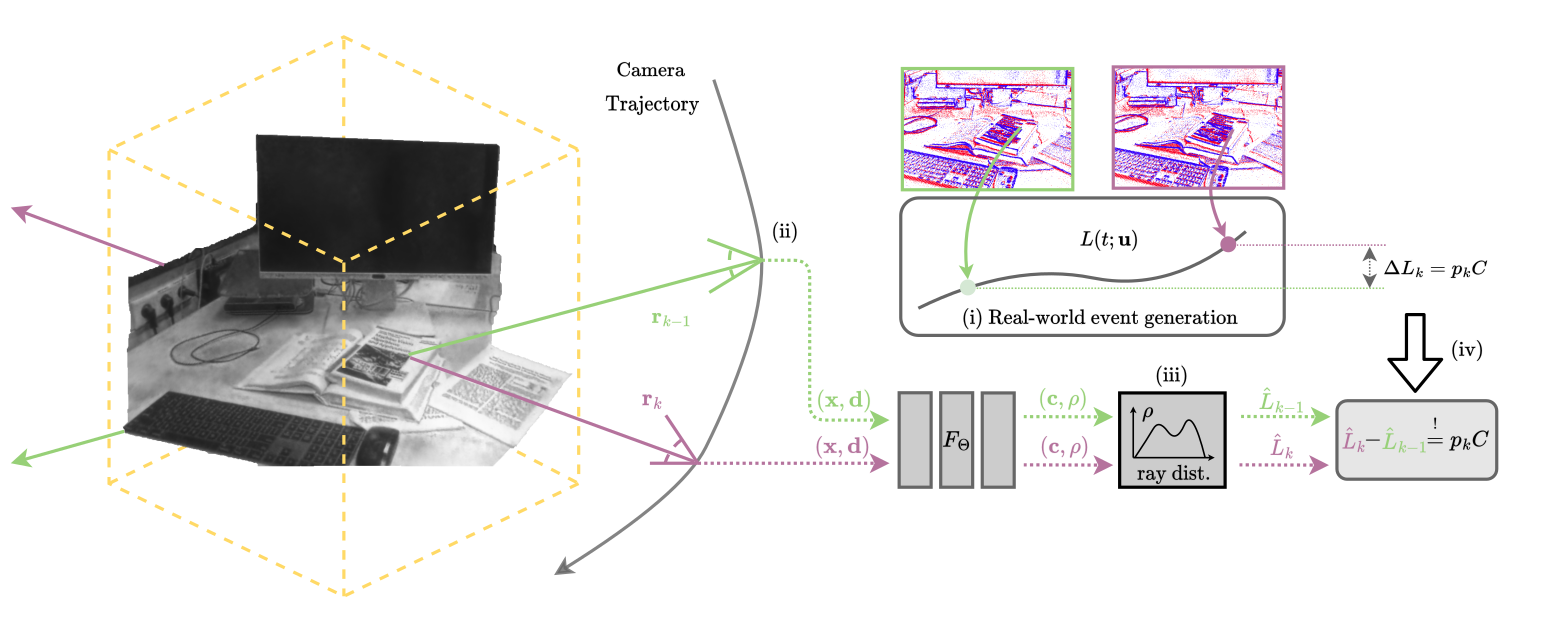E-NeRF computes a Neural Radiance Field from event-camera data. It is a joint work by
Simon Klenk1 Lukas Koestler1 Davide Scaramuzza2 Daniel Cremers1
1Computer Vision Group, Technical University of Munich, Germany
2 Robotics and Perception Group, University of Zurich, Switzerland.
IEEE Robotics and Automation Letters (RA-L), 2023 &
International Conference on Intelligent Robots and Systems (IROS), 2023
If you use this code or our paper results, please cite our work. link to paper
@article{klenk2022nerf,
title={E-NeRF: Neural Radiance Fields from a Moving Event Camera},
author={Klenk, Simon and Koestler, Lukas and Scaramuzza, Davide and Cremers, Daniel},
journal={IEEE Robotics and Automation Letters},
year={2023}
}
Datasets were simulated using esim. It can be found under https://vision.in.tum.de/research/enerf.
Our python implementation is based on torch-ngp - a pytorch implementation of instant-ngp, as described in Instant Neural Graphics Primitives with a Multiresolution Hash Encoding.
git clone --recursive https://github.com/knelk/enerf
cd enerfconda env create -f environment.yml
conda activate enerfpython3 -m venv env
source env/bin/activate
pip install -r requirements.txt- Ubuntu 20.04 with torch 1.10 & CUDA 11.12.2 on an NVIDIA RTX A4000.
We support 3 data formats: esim, tumvie, and eds. The data format is quite flexible and easy-to-adapt, e.g. to feed COLMAP poses or similar (have a look at nerf/provider.py and the scripts folder for data preprocessing, and associated issues in torch-ngp).
./configs should be a good starting point to understand the most important flags of our code. Important event-related flags include C_thres (-1 for using the normalized loss function), events (boolean), event_only (boolean) and accumulate_evs (boolean). The scene is assumed to be in [-bound, bound], and centered at (0, 0, 0).
Please refer to torch-ngp and its issues for more details regarding the installation, usage and scene assumptions.
- Check the scripts folder.
- For tumvie, download data to
TUMVIEDATA. Left grayscale camera = camId0, right grayscale camera = camId1. - Run
python ./scripts/undistort_images_tumvie.py --indir TUMVIEDATA --camId 0to undistort the left images, events (by creating rectify_map_left/right.h5), and intrinsics. Before running the script, copy the respective calibration file (e.g.camera-calibrationA.jsonformocap-desk2) ascalibration.jsonintoTUMVIEDATA, and copy the respective imu-calibration file (e.g.camera-calibrationA.jsonformocap-desk2) asmocap-imu-calib.jsonintoTUMVIEDATA. See tumvie homepage for details. - Similarly, run
./scripts/undistort_images_eds.pyto undistort the images, events (by creating rectify_map_left/right.h5), and intrinsics of the eds dataset (download tgz version).
We provide a script for rendering. For example, to render the trained E-NeRF model at the keyframe (kfs) validation (val) poses, simply run python scripts/render.py --model_dir EXPDIR --infile EXPDIR/val_final_quatlist_kfs_ns.txt. If you want random poses (around the training poses), do not provide and infile and set rand_poses=1.
- Take care that the poses you provide are in the correct format (right_up_back, check e.g. this issue or this issue which also explains the idea behind
poses_bounds.pyformat). - Take care to undistort the images/events/e2vid-reconstructions that you are feeding to the NeRF model, as described above in Data Preprocessing.
- If the program sometimes does not start due to CUDA issues (or it gets stuck after loading the model), I often found it useful to clear the cache
rm -rf ~/.cupy/ ~/.ccache/ ~/.cache/, and sometimes (rm -rf __pycache__/ raymarching/__pycache__/ gridencoder/__pycache__/ utils/__pycache__/ nerf/__pycache__/ shencoder/__pycache__/).
@misc{torch-ngp,
Author = {Jiaxiang Tang},
Year = {2022},
Note = {https://github.com/ashawkey/torch-ngp},
Title = {Torch-ngp: a PyTorch implementation of instant-ngp}
}
-
tiny-cuda-nn and instant-ngp:
@misc{tiny-cuda-nn, Author = {Thomas M\"uller}, Year = {2021}, Note = {https://github.com/nvlabs/tiny-cuda-nn}, Title = {Tiny {CUDA} Neural Network Framework} } @article{mueller2022instant, title = {Instant Neural Graphics Primitives with a Multiresolution Hash Encoding}, author = {Thomas M\"uller and Alex Evans and Christoph Schied and Alexander Keller}, journal = {arXiv:2201.05989}, year = {2022}, month = jan } -
The tumvie dataset:
@inproceedings{klenk2021tum,
title={Tum-vie: The tum stereo visual-inertial event dataset},
author={Klenk, Simon and Chui, Jason and Demmel, Nikolaus and Cremers, Daniel},
booktitle={2021 IEEE/RSJ International Conference on Intelligent Robots and Systems (IROS)},
pages={8601--8608},
year={2021},
organization={IEEE}
}
- The eds dataset:
@inproceedings{hidalgo2022event,
title={Event-aided Direct Sparse Odometry},
author={Hidalgo-Carri{\'o}, Javier and Gallego, Guillermo and Scaramuzza, Davide},
booktitle={Proceedings of the IEEE/CVF Conference on Computer Vision and Pattern Recognition},
pages={5781--5790},
year={2022}
}
- E2VID reconstruction were created with this repository: e2calib
@Article{Rebecq19pami,
author = {Henri Rebecq and Ren{\'{e}} Ranftl and Vladlen Koltun and Davide Scaramuzza},
title = {High Speed and High Dynamic Range Video with an Event Camera},
journal = {{IEEE} Trans. Pattern Anal. Mach. Intell. (T-PAMI)},
url = {http://rpg.ifi.uzh.ch/docs/TPAMI19_Rebecq.pdf},
year = 2019
}
